The White-Cheeked Barbet (Psilopogon viridis) is a charming and distinctive bird species native to the lush forests of southern India.
With its striking brown and green plumage adorned by a whitish supercilium and cheek stripe, this avian friend captivates the hearts of birdwatchers and nature enthusiasts alike.
Measuring between 20 and 25 centimeters in length and weighing around 70 to 90 grams, it thrives in the forested habitats of the Western Ghats, Eastern Ghats, and adjoining hills.
Primarily frugivorous, it feasts on various fruits while occasionally supplementing its diet with insects. Known for its vocal prowess during the breeding season, the White-Cheeked Barbet adds melody to the vibrant ecosystems it inhabits.
Physical Characteristics of White-Cheeked Barbet
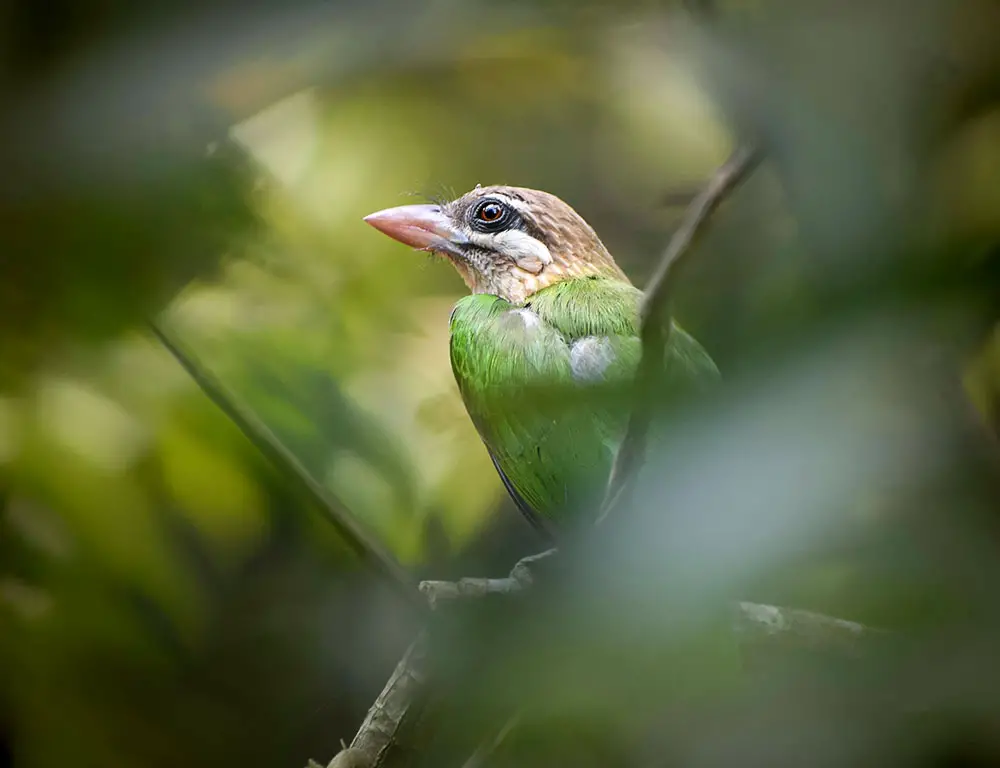
The White-Cheeked Barbet (Psilopogon viridis) is a delightful and distinctive bird species found primarily in the forested regions of southern India, particularly in the Western Ghats and adjoining hills.
Here are its notable physical characteristics:
Size and Weight
The White-Cheeked Barbet typically measures between 20 and 25 centimeters (about 8 to 10 inches) in length, making it a relatively compact bird. It weighs approximately 70 to 90 grams, giving it a sturdy and robust build for its size.
Coloration
- Head: The head of the White-Cheeked Barbet is predominantly brown, adorned with white streaks, creating a distinctive capped appearance.
- Facial Features: One of its most striking features is the whitish supercilium, a stripe of feathers above the eye, and a broad whitish cheek stripe below it. These markings accentuate its facial structure and make it easily recognizable.
- Body: The body of the White-Cheeked Barbet is primarily adorned in shades of green, blending seamlessly with the lush foliage of its forest habitat. This green plumage provides excellent camouflage in the dense canopy.
Beak
Like other members of the Barbet family, the White-Cheeked Barbet sports a stout, slightly curved bill. This specialized beak is well-adapted for its frugivorous diet, allowing it to grasp and consume various fruits quickly.
Additionally, the vital bill aids in excavating nest cavities in trees, where the barbet raises its young.
Wings and Tail
The White-Cheeked Barbet has broad wings and a short tail, ideal for navigating through the dense vegetation of its forest habitat. These features enable it to maneuver swiftly among the branches while foraging for food or evading potential predators.
Voice
During the breeding season, White-cheeked Barbets become notably vocal, emitting a distinctive call characterized by a monotonous “Kot-roo…Kotroo…” with an explosive “trrr” at the start.
This vocalization serves various purposes, including territorial defense and courtship displays.
Distribution of White-Cheeked Barbet
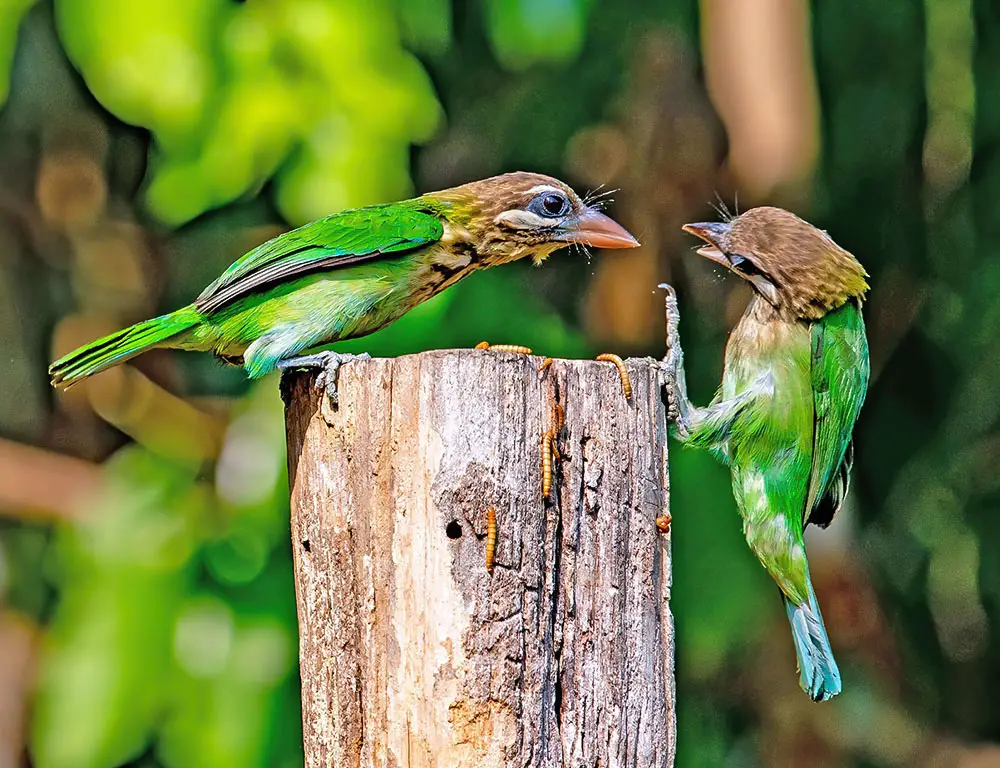
The White-Cheeked Barbet (Psilopogon viridis) is primarily found in the forested regions of southern India, with its distribution centered around the Western Ghats and adjoining hills.
Here’s a more detailed overview of its distribution:
Southern India
The White-Cheeked Barbet is endemic to the southern Indian subcontinent, particularly the states of Kerala, Tamil Nadu, Karnataka, and parts of Andhra Pradesh.
It inhabits the forested areas within these states, including the Western Ghats, Eastern Ghats, and their foothills.
Western Ghats
This bird species is commonly encountered in the Western Ghats, a mountain range that runs parallel to the western coast of India.
It can be found in various forest habitats within the Western Ghats, including tropical evergreen forests, moist deciduous forests, and shola-grassland ecosystems.
Eastern Ghats
While less common than in the Western Ghats, the White-Cheeked Barbet is also present in parts of the Eastern Ghats, extending along India’s eastern coast. It occurs in fragmented forest patches within this region.
Adjoining Hills
Apart from the Western and Eastern Ghats, the White-Cheeked Barbet’s distribution extends to the adjoining hills and mountainous areas in southern India. This includes hilly terrain in regions like the Nilgiris, Anaimalai Hills, Palani Hills, and other smaller hill ranges.
Diet of White-Cheeked Barbet
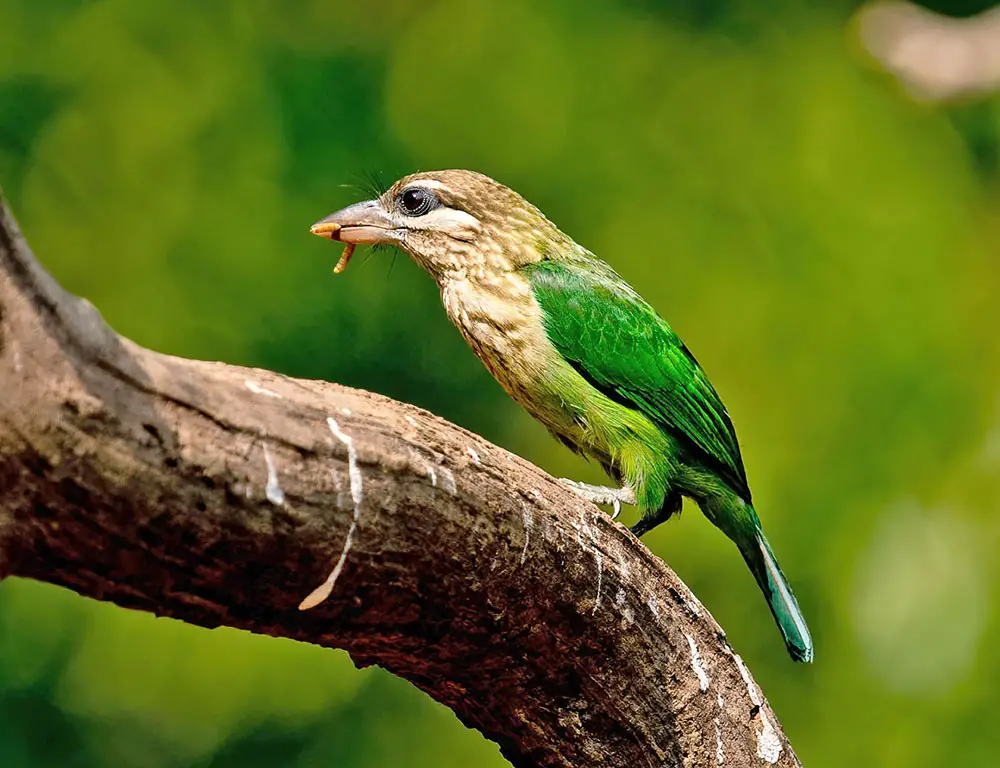
The White-Cheeked Barbet (Psilopogon viridis) is primarily frugivorous, meaning its diet consists mainly of fruits. However, it may also supplement its diet with other food items.
Here are the main components of the White-Cheeked Barbet’s diet:
Fruits
Fruits constitute the bulk of the White-Cheeked Barbet’s diet. It feeds on various fruits, including berries, figs, drupes, and other soft fruits. The barbet’s stout, slightly curved bill is well-adapted for grasping and consuming these fruits.
Insects
While fruits are the primary food source, White-cheeked Barbets may also consume insects, especially during the breeding season or when fruit availability is limited. Insects such as beetles, caterpillars, ants, and termites may be taken opportunistically.
Other Food Items
Occasionally, White-cheeked Barbets may consume other food items such as flower nectar, sap, and even small vertebrates like lizards or tiny frogs. However, these items are secondary to fruits and insects in their diet.
Behavior of White-Cheeked Barbet
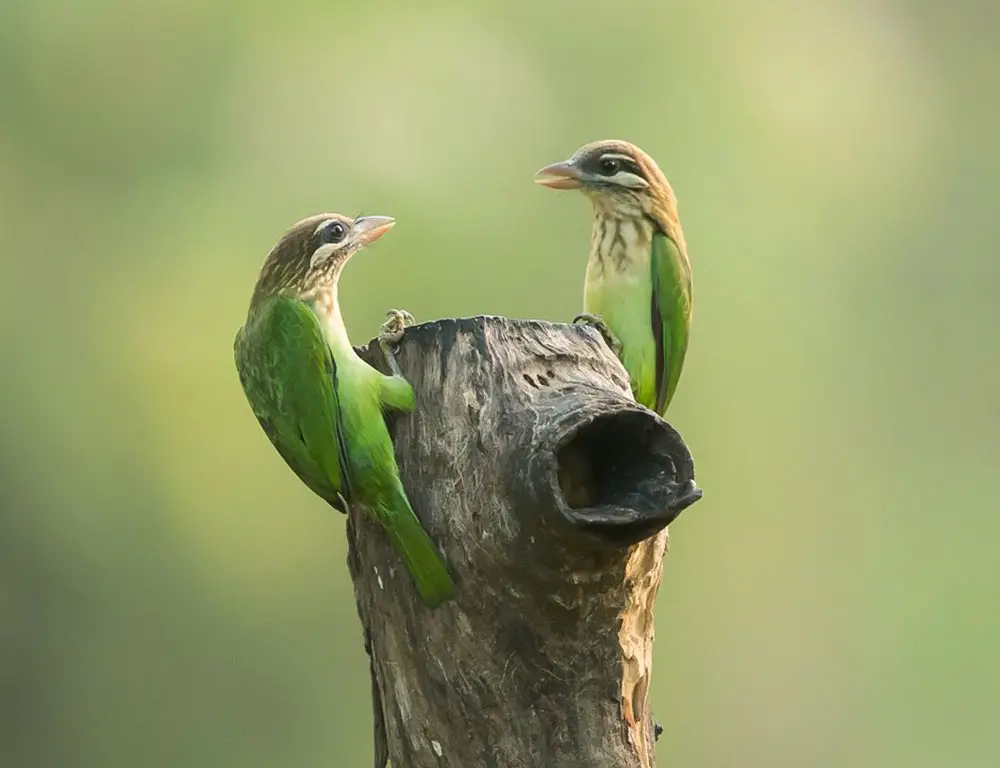
The White-Cheeked Barbet (Psilopogon viridis) exhibits various interesting behaviors, reflecting its adaptation to its forested habitat and frugivorous diet.
Here are some notable aspects of its behavior:
Foraging
White-Cheeked Barbets are primarily frugivorous, meaning they predominantly feed on fruits. They forage for ripe fruits in the forest canopy, using their stout bills to grasp and consume various fruits, including berries, figs, and other soft fruits.
They may also occasionally feed on insects and small invertebrates.
Vocalizations
During the breeding season, White-cheeked Barbets become more vocal, emitting a distinctive call characterized by a monotonous “Kot-roo…Kotroo…” with an explosive “trrr” at the start.
These vocalizations serve various purposes, including territorial defense, communication with mates, and establishing their presence within their habitat.
Territoriality
White-Cheeked Barbets are known to be territorial birds, defending their feeding and breeding territories from intruders. They may vocalize loudly or engage in physical displays, such as fluffing their feathers or chasing away rivals, to assert dominance and maintain their territory.
Breeding
Like many bird species, White-Cheeked Barbets engage in courtship rituals during breeding. Males may perform elaborate displays, including aerial acrobatics or offering food to females, to attract mates.
They typically nest in tree cavities, which they excavate using their stout bills, and both parents take turns incubating the eggs and feeding the young.
Social Behavior
While White-Cheeked Barbets are generally seen in pairs or small family groups during the breeding season, they may also form larger flocks outside of the breeding season, especially when foraging for food resources.
These flocks may consist of individuals from multiple families or even different species of birds.
Roosting
At night, White-Cheeked Barbets roost in tree cavities or dense foliage, where they are protected from predators and the elements. These roosting sites may vary depending on habitat availability and seasonal changes.
Habitat of White-Cheeked Barbet
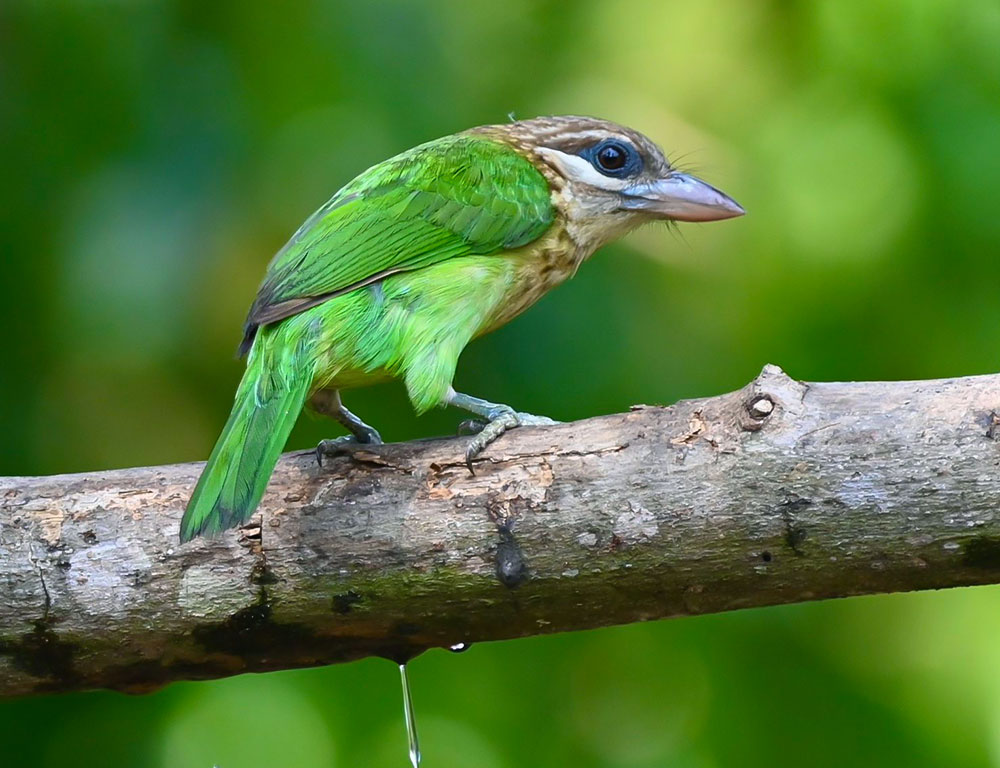
The White-Cheeked Barbet (Psilopogon viridis) is predominantly found in forested habitats, particularly in the southern regions of India. Its habitat preferences include:
Tropical Evergreen Forests
White-Cheeked Barbets are commonly associated with tropical evergreen forests characterized by dense vegetation, towering trees, and a rich diversity of plant species.
These forests provide ample food resources through fruits and shelter in tree cavities for nesting.
Montane Forests
The White-Cheeked Barbet can also be found within its range in montane forests, which occur at higher elevations. These forests may have slightly different species composition than lowland forests but still provide suitable habitat for the barbet.
Subtropical Moist Forests
In addition to tropical evergreen and montane forests, the White-Cheeked Barbet may inhabit subtropical moist forests in certain parts of its range.
These forests experience a milder climate than lowland tropical forests but still provide suitable conditions for the species.
Forest Edge and Clearings
While White-Cheeked Barbets prefer the interior of undisturbed forests, they may also be found in forest edge habitats or clearings, especially if there are nearby fruiting trees. However, they typically avoid highly disturbed or fragmented habitats.
Human-Altered Landscapes
In some cases, White-Cheeked Barbets may also occur in human-altered landscapes such as wooded gardens, orchards, and plantations, as long as suitable vegetation and food resources are present. However, they are less common in heavily urbanized or agricultural areas.
Nesting Behavior of White-Cheeked Barbet

The nesting behavior of the White-Cheeked Barbet (Psilopogon viridis) is fascinating and involves several distinctive characteristics:
Nest Site Selection
White-Cheeked Barbets typically nest in tree cavities. They often choose a suitable tree with a cavity large enough to accommodate their nest. While they may excavate their cavities in softer wood, they frequently utilize natural hollows or abandoned woodpecker holes.
Nest Construction
Once a suitable nest site is selected, the male and female White-Cheeked Barbets prepare the nest. They may line the cavity with leaves, twigs, and other plant materials to create a soft, insulated nesting chamber.
Egg Laying and Incubation
The female White-Cheeked Barbet lays a clutch of eggs, typically ranging from 2 to 4, although clutch size can vary. Both parents take turns incubating the eggs, with the female usually incubating during the day and the male taking over at night.
This shared parental duty helps ensure the eggs are consistently warmed and protected.
Parental Care
Once the eggs hatch, both parents participate in caring for the nestlings. They feed the chicks a diet consisting primarily of regurgitated fruit pulp and occasionally insects. The young chicks proliferate under the care of their attentive parents.
Fledging
After a few weeks, the young White-Cheeked Barbets are ready to leave the nest. They fledge and begin to explore their surroundings under the watchful eyes of their parents.
Even after fledging, the parents continue providing food and guidance to their offspring until they become independent.
Nest Reuse
White-Cheeked Barbets may reuse the same nest cavity for multiple breeding seasons, mainly if it provides adequate protection and is not taken over by other bird species.
Conservation Status of White-Cheeked Barbet
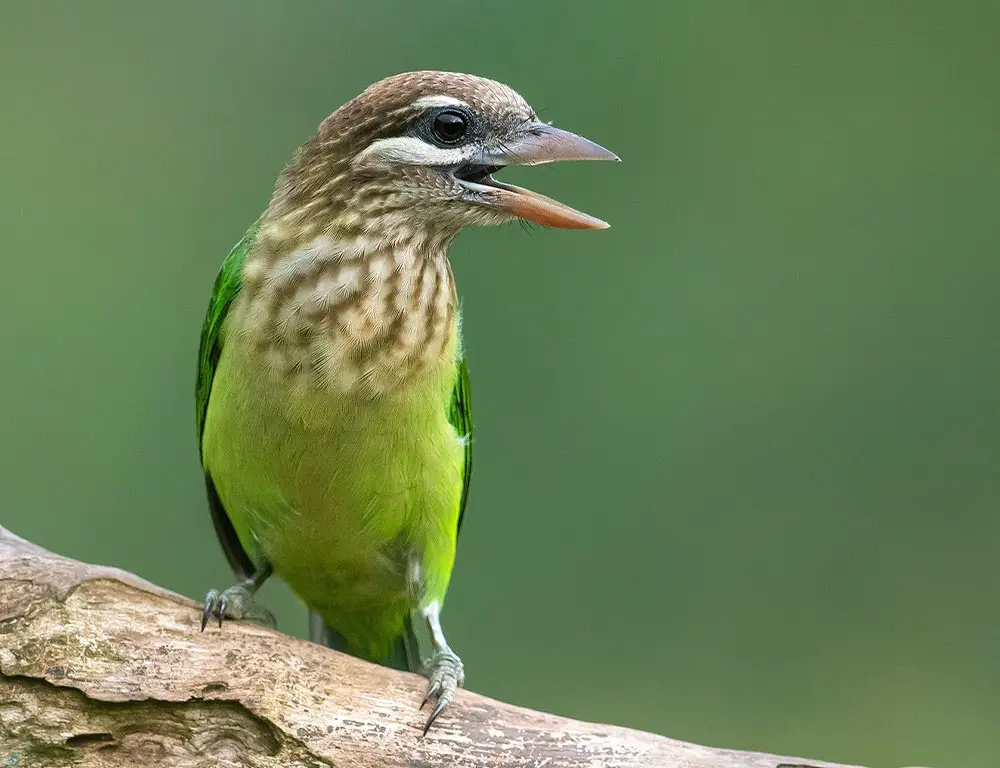
The White-Cheeked Barbet (Psilopogon viridis) holds a conservation status of “Least Concern” according to the International Union for Conservation of Nature (IUCN) Red List. This designation suggests that the species does not currently face immediate threats of extinction.
However, this assessment does not imply that the bird lacks conservation concerns. Several factors contribute to the overall conservation status of the White-Cheeked Barbet:
Habitat Loss
Like many other bird species, the White-Cheeked Barbet is affected by habitat loss and degradation.
Deforestation, urbanization, and agricultural expansion pose significant threats to its natural habitat in the forests of southern India, including the Western Ghats and parts of the Eastern Ghats.
Fragmentation
Habitat fragmentation further exacerbates the challenges faced by the White-Cheeked Barbet. As forests become fragmented into smaller patches, the bird’s ability to find suitable nesting sites, forage for food, and move between habitats can be compromised.
Climate Change
The impacts of climate change, including altered precipitation patterns, temperature fluctuations, and habitat shifts, can indirectly affect the White-Cheeked Barbet and its ecosystem.
These changes may disrupt breeding cycles, alter food availability, and increase the species’ susceptibility to other stressors.
Human-Wildlife Conflict
Encounters with humans can lead to conflicts, particularly in areas where human activities intersect with the bird’s habitat. These conflicts may result in habitat disturbance, nest destruction, or direct harm to the birds.
FAQs
What is the lifespan of the White-Cheeked Barbet?
The average lifespan of a White-Cheeked Barbet in the wild is typically around 8 to 10 years. However, in captivity, they may live longer under optimal conditions.
Are White-Cheeked Barbets migratory birds?
White-Cheeked Barbets are generally non-migratory birds, meaning they do not undertake long-distance migrations. They are known to reside year-round in their preferred habitats, primarily in southern India.
Do White-Cheeked Barbets have any predators?
While adult White-chewed Robbets are relatively safe from predation due to their size and agility, their nests and young may be vulnerable to predation by snakes, raptors, and other predators that target bird nests.
Can White-Cheeked Barbets be kept as pets?
In many regions, it is illegal to keep native wild birds like the White-Cheeked Barbet as pets. Additionally, these birds have specialized dietary and environmental requirements that are difficult to meet in captivity, making them unsuitable as pets.
Are there any cultural or symbolic associations with the White-Cheeked Barbet?
In some cultures, birds like the White-Cheeked Barbet may hold symbolic significance or feature in folklore and traditional stories. However, specific cultural associations may vary depending on regional beliefs and traditions.
To Recap
The White-Cheeked Barbet (Psilopogon viridis) stands as a symbol of the rich biodiversity and natural beauty of southern India’s forested landscapes.
Its distinctive appearance, characterized by brown and green plumage adorned with a whitish supercilium and cheek stripe, makes it a delightful sight for birdwatchers and conservationists.
As a frugivorous species, it plays a crucial role in seed dispersal within its habitat, contributing to maintaining ecosystem health and diversity.
Through its vocalizations, nesting behaviors, and dietary habits, the White-Cheeked Barbet embodies the interconnectedness of all living beings in the intricate web of nature.
Preserving its forest habitat is not only essential for the survival of this charming bird but also for the conservation of the entire ecosystem it inhabits.